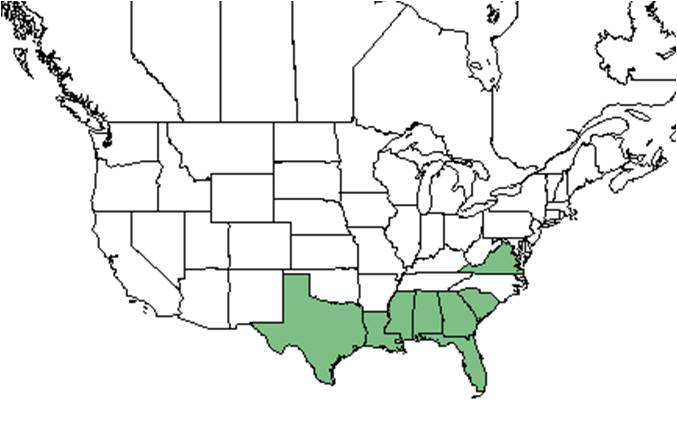Difference between revisions of "Ruellia ciliosa"
(→Taxonomic notes) |
|||
| Line 20: | Line 20: | ||
Common names: Sandhills wild petunia, Ciliate wild petunia.<ref name="Nelson 2006"/> | Common names: Sandhills wild petunia, Ciliate wild petunia.<ref name="Nelson 2006"/> | ||
==Taxonomic notes== | ==Taxonomic notes== | ||
| − | Subspecies: ''R. caroliniensis (J.F. Gmelin) Steudel ssp. ciliosa (Pursh) R.W. Long var. cinerascens (Fernald) Kartesz & Gandhi | + | Subspecies: ''R. caroliniensis'' (J.F. Gmelin) Steudel ssp. ''ciliosa'' (Pursh) R.W. Long var. ''cinerascens'' (Fernald) Kartesz & Gandhi; ''R. caroliniensis'' ssp. ''ciliosa'' var. ''ciliosa''.<ref>Nelson, G. [http://www.gilnelson.com/ PanFlora]: Plant data for the eastern United States with emphasis on the Southeastern Coastal Plains, Florida, and the Florida Panhandle. www.gilnelson.com/PanFlora/ Accessed: 19 MAY 2021</ref> |
| − | Varieties: ''R. ciliosa var. cinerascens | + | Varieties: ''R. ciliosa'' var. ''cinerascens'' Fernald; ''R. ciliosa'' var. ''typica''.<ref>Nelson, G. [http://www.gilnelson.com/ PanFlora]: Plant data for the eastern United States with emphasis on the Southeastern Coastal Plains, Florida, and the Florida Panhandle. www.gilnelson.com/PanFlora/ Accessed: 19 MAY 2021</ref> |
==Description== | ==Description== | ||
Revision as of 13:41, 8 June 2021
| Ruellia ciliosa | |
|---|---|

| |
| Photo taken by Gil Nelson | |
| Scientific classification | |
| Kingdom: | Plantae |
| Division: | Magnoliophyta – Flowering plants |
| Class: | Magnoliopsida – Dicotyledons |
| Order: | Scrophulariales |
| Family: | Acanthaceae |
| Genus: | Ruellia |
| Species: | R. ciliosa |
| Binomial name | |
| Ruellia ciliosa (Pursh) R.W. Long | |

| |
| Natural range of Ruellia ciliosa from USDA NRCS Plants Database. | |
Common names: Sandhills wild petunia, Ciliate wild petunia.[1]
Contents
Taxonomic notes
Subspecies: R. caroliniensis (J.F. Gmelin) Steudel ssp. ciliosa (Pursh) R.W. Long var. cinerascens (Fernald) Kartesz & Gandhi; R. caroliniensis ssp. ciliosa var. ciliosa.[2]
Varieties: R. ciliosa var. cinerascens Fernald; R. ciliosa var. typica.[3]
Description
"Perennial herbs. Leaves opposite, acute or obtuse, entire or undulate, base cuneate to attenuate, sessile or petiolate. Flowers in dense glomerules or in open cymes. Calyx tube short, lobes 5, elongate; corolla blue or rarely pink, funnel form, with tube, open throat, and 5 subequal lobes; stamens 4, included, anther locules parallel; stigmas 2-cleft. Capsules brown or yellow brown, compressed, ellipsoid-obovoid; seeds several, brown or gray."[4]
"Dwarf, pubescent perennial 0.5-1.5 dm tall, with a basal rosette. Leaves spatulate, obovate, or oblanceolate, to 7 cm long and 3 cm wide, pubescent, sessile or subsessile. Flowers in dense, sessile or subsessile, axillary glomerules. Calyx lobes hirsute, linear-setaceous, 15-30 mm long; corolla 3-4 cm long, tube longer than throat, lobes to 2 cm long. Capsules glabrous, 12-18 mm long, 5-6 mm broad; seeds gray, 3-4 mm long."[4]
Distribution
It is found in sandhills of Florida, Georgia, South Carolina, and North Carolina.[1]
Ecology
Habitat
In the Coastal Plain in Florida, it can be found in recently burned longleaf pine wiregrass woods, longleaf pine sandhills, burned longleaf pine ridges, open woodlands, turkey-oak-pinelands, scrub oak barrens, pine savannas, annually burned savannas and annually burned hardwoods.[5] It can also be found along roadsides, disturbed turkey oak-pinewoods, and pine-hardwood clearings. It grows in sandy loam and sandy soil. [5] Associated species include Sporobolus junceus, turkey oak and bluejack oaks.[5]
Phenology
This species has been observed to flower from May through September and in response to fire.[1][5][6] Kevin Robertson has observed this species flower within three months of burning KMR.
Fire ecology
It flowers within two months of burning in early summer (KMR). Ruellia ciliosa responds rapidly to fire and may be seen as one of the more common plants in longleaf pine native ground cover after a prescribed burn. Within a few weeks or so, Ruellia ciliosa, produces new leaves and flowers profusely but temporary[1](KMR). It was also observed to flower in areas raked and cleared of litter other vegetation in a longleaf pine-wiregrass site which otherwise had not burned for several years, suggesting that it germinates and flowers in response to to light (KMR).
Conservation and management
Cultivation and restoration
Photo Gallery
References and notes
Robertson, Kevin M. 2014. Personal observation made at Pebble Hill Plantation, Grady County, Georgia.
- ↑ 1.0 1.1 1.2 1.3 Nelson, Gil. Atlantic Coastal Plain Wildflowers: A Field Guide to the Wildflowers of the Coastal Regions of Virginia, North Carolina, South Carolina, Georgia, and Northeastern Florida. Guilford, CT: FalconGuide, 2006. 36. Print.
- ↑ Nelson, G. PanFlora: Plant data for the eastern United States with emphasis on the Southeastern Coastal Plains, Florida, and the Florida Panhandle. www.gilnelson.com/PanFlora/ Accessed: 19 MAY 2021
- ↑ Nelson, G. PanFlora: Plant data for the eastern United States with emphasis on the Southeastern Coastal Plains, Florida, and the Florida Panhandle. www.gilnelson.com/PanFlora/ Accessed: 19 MAY 2021
- ↑ 4.0 4.1 Radford, Albert E., Harry E. Ahles, and C. Ritchie Bell. Manual of the Vascular Flora of the Carolinas. 1964, 1968. The University of North Carolina Press. 973. Print.
- ↑ 5.0 5.1 5.2 5.3 Florida State University Robert K. Godfrey Herbarium database. URL: http://herbarium.bio.fsu.edu. Last accessed: July 2015. Collectors: Loran C. Anderson, A.B. Seymour, A.E. Radford, Sidney McDaniel, R. F. Thorne, R. A. Davidson, Robert Kral, Robert K. Godfrey, Gary R. Knight, Bill & Pam Anderson, Ann F. Johnson, Roy Komarek. States and Counties: Alabama: Baldwin. Florida: Bay, Gadsden, Jackson, Levy, Liberty, Monroe, Okaloosa, Santa Rosa, Wakulla, Washington. Georgia: Grady, Thomas. Mississippi: Jackson. South Carolina: Sumter. Compiled by Tall Timbers Research Station and Land Conservancy.
- ↑ Nelson, G. PanFlora: Plant data for the eastern United States with emphasis on the Southeastern Coastal Plains, Florida, and the Florida Panhandle. www.gilnelson.com/PanFlora/ Accessed: 19 MAY 2021